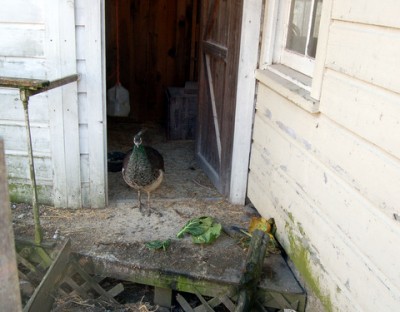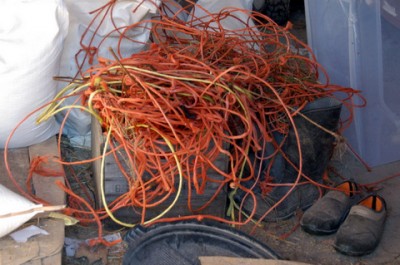AgriCulture bloggers Peter Davies and Mark Scherzer are the owners of Turkana Farms in Germantown, NY. This week Mark writes.

It’s the eve of the departure of our geese and ducks to be transformed into festive holiday dinners. For us, who don’t make it to the malls very often, it’s another reminder that the holiday season is upon us. As so many people have long lamented, this season of charity and giving seems long ago to have been swallowed by a focus on buying and consuming. And like many others, I have a complex relationship with the buying and consuming part. Acquiring things, in my case, is something of a dangerous activity, because once I have them they tend to be with me for life. As Peter has told me, I have the soul of a hoarder. On the theory of “waste not, want not,” I am, like a beaver, constantly erecting dams to interrupt the flow of the waste stream. In this respect, the farm has been a terrible reinforcer of my instincts. This season, for example, I would characterize as a vast project of recycling, of taking what remains from our various summer and early fall projects and “repurposing” them, to use current technocratic jargon.

Start with the garden. As the growing season closes down, we make a major effort to make use of what’s left there. Corn stalks (including all the over the hill cobs), together with pumpkin, squash, tomato and bean vines (and any frozen beans left on them), are gathered and hauled down to the pigs. The outer leaves of all the brassicas — cabbage, broccoli, cauliflower, brussel sprouts — are plucked for the chickens and peafowl, who greatly appreciate this greenery now that we are no longer pulling baskets of weeds from the garden and no greens remain to be eaten in their yard. The stalks and cores, again, go to the appreciative pigs. In a better season, when their fruit crop has not been close to wiped out by adverse weather events, our neighbors, the Riders, get into the act and provide us with endless boxes of their unsaleable or bruised apples and pears. We use them to entice the cows to move where we want them to go. The remainder go, yes again, to the pigs, our all-purpose recycling machines. We don’t stop with the garden, however. After the turkeys leave, we immediately put away the steel perching bars on which they’ve been roosting in their sleeping porch. This allows our neighbor, Neil Hegeman, to come in with his tractor and scoop out the floor. The mixture of grain, decomposed straw, and turkey droppings are most excellent ingredients for the little compost mountain we’re building for next year. And the scooped out sleeping porch, carpeted with fresh straw, becomes the sleeping, and winter storm shelter for our bull, cows, and calves. Tomorrow a shelter that stands out in the middle of the goose yard, will, with the geese departed, acquire a new use. It will protect a large manger from the rain and snow. We will fill that manger with hay for the sheep weekly until May when they can rely on grazing again. And the goose yard itself will be opened to the sheep, who will, in a matter of a couple of weeks, clear down all the weeds the geese did not see fit to eat all summer. Waste not, want not. Recycling like this is, I believe, characteristic of many farms besides our own. And many farmers, if our observation is correct, create little reservoirs of “stuff,” things that have been put aside with the expectation that while their original uses have been lost, with some slight modification they’ll come in handy for some other purpose...some day.

When we first bought our place among its assets (if you ask me) or detriments (according to Peter) was an impressive array of junked farm machinery and old fencing at what is now the southern end of our pasture. It had been there long enough for a copse of trees to grow up through it. The son of the owner told us he wanted the machinery and would at some point take it away, and to me that was fine. It looked like a rustic treasure trove that was more or less invisible, and might at some point yield valuable parts for our various activities. To Peter, who feels that farms need not look like junkyards, it was a disturbing intrusion, and finally, nearly a year after we had moved in, he had all of it — six flat bed trucks worth — carted away. I pined. But since then I’ve had plenty of opportunity, often in a tug of war with Peter, to accumulate new, smaller collections of what I think will be useful stuff, in various corners of the farm. And I’ve found that, if you are discreet, they really do become invisible (to me) or at least that it takes some time before Peter notices and decrees a cleanup. I realize just how effective I’ve been when we have to clean out areas for emerging uses. This last month, we cleaned the garage out so we had sufficient room to sort turkeys and a pen in the barn that we needed for hay storage, and I was constantly rescuing and setting aside what I deemed valuable items from what Peter determined was a discard pile.

What do I save for deposit in these little treasure troves? Such items as pieces of old hose, which make ideal lengths of insulation where needed along the electric fence lines. Infinite lengths of hay twine for tying things up. Baling wire, ideal for securing metal fencing when the fence clips won’t reach. Empty plastic containers and tin cans, which become vessels for scooping out or transporting animal feed. Old, unsold bags of wool, which can be used as insulation around the base of the greenhouse. The concrete chunks of a broken down birdhouse, to be used where we need rocks as ballast. The frames of old broken screen windows, which can be converted to covers for brooder pens. The clamps that once secured a heat lamp to a wood beam because, well, you never know. At times, I must admit that I may carry this instinct to an extreme. I recall last year finding, in a bag destined for the dump, a pair of flannel lined jeans, the outer denim shell of which had been torn in several places when I was climbing over fences and the like. Peter had told me I should throw them out, but I resisted. He took matters into his own hands. I countered by rescuing and secreting them, or so I thought. I placed them in a corner of the garage where I thought they would go unnoticed until I returned from errands and could sneak them back into the house. Unfortunately, as is so often the case with these items I’ve carefully saved, I quickly forgot them and they receded to invisibility. Until the next weekend, that is. As I was gathering items for my weekly trip to the dump, where I dispose of the items we agree actually belong in the waste stream, I saw a mysterious object in the driveway. A zipper, around which were a few charred flakes of something that had been burned up. It took a few moments, but I ultimately realized that I had lost this battle, Peter had poured kerosene on the jeans and torched them. Truth be told, I briefly considered whether I ought to save and put in the drawer the zipper that remained, because it might come in handy some day. Waste not, want not.









